Forensic Toxicology 5: Human Growth Hormone (HGH) Investigation Report
VerifiedAdded on 2020/04/15
|7
|1684
|73
Report
AI Summary
This report, titled "FORENSIC TOXIC 5: HUMAN GROWTH HORMONE (HGH)", investigates Human Growth Hormone (HGH) or Somatotropin, focusing on its pharmacological action and detection in human specimens. The paper begins with an overview of HGH, secreted by the pituitary gland, and its role in growth, metabolism, and body composition. It details both the direct and indirect physiological effects of HGH, including its impact on fat, protein, and carbohydrate metabolism, and its effects on the IGF-I hormone. The report further examines the use of HGH as a performance-enhancing substance in sports, its potential benefits, and the associated health risks and side effects. It discusses synthetic HGH's approved medical uses and its common off-label applications, emphasizing the need for proper testing methods, including blood tests, to detect HGH. The report concludes with a discussion on the importance of random testing to prevent athletes from using supplements and to ensure accurate diagnoses.
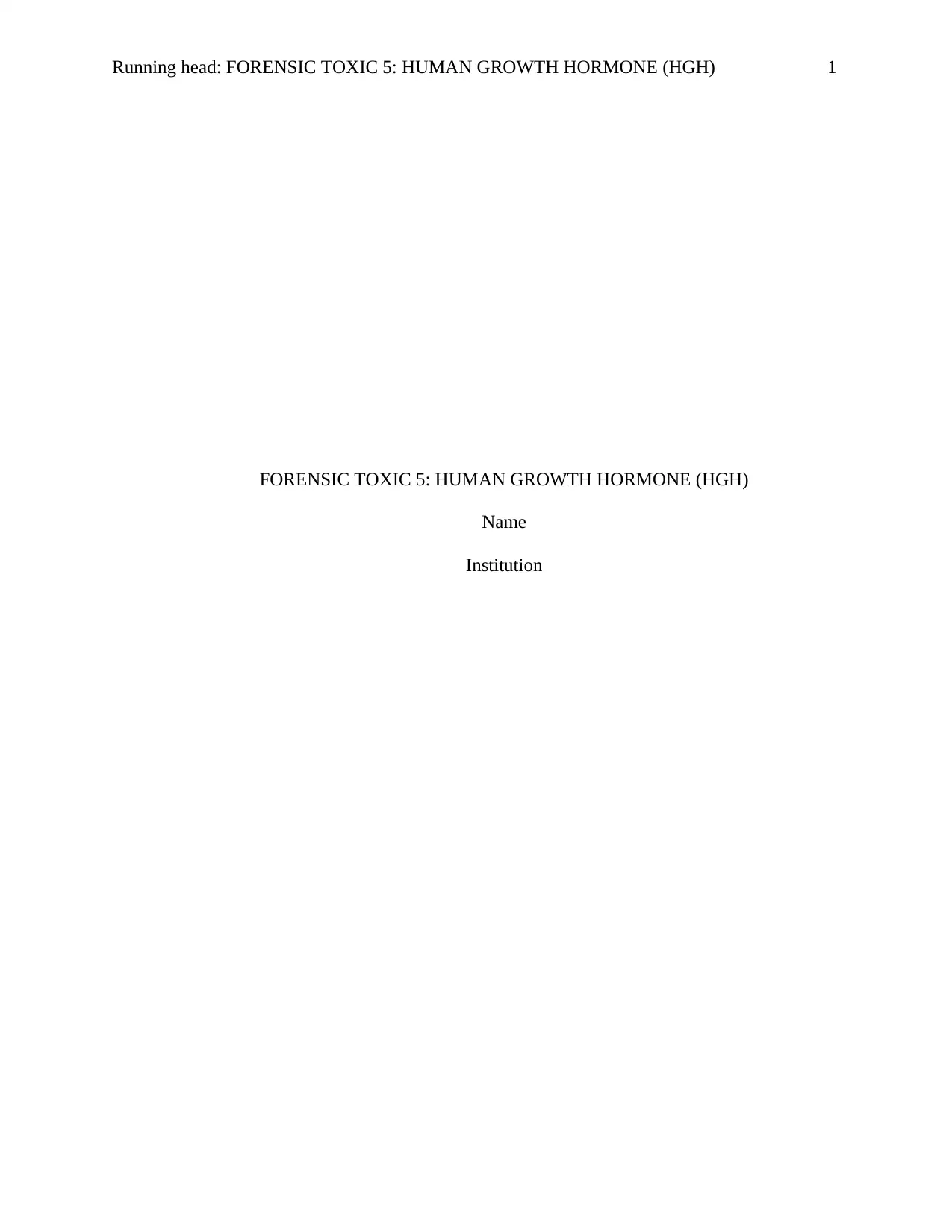
Running head: FORENSIC TOXIC 5: HUMAN GROWTH HORMONE (HGH) 1
FORENSIC TOXIC 5: HUMAN GROWTH HORMONE (HGH)
Name
Institution
FORENSIC TOXIC 5: HUMAN GROWTH HORMONE (HGH)
Name
Institution
Paraphrase This Document
Need a fresh take? Get an instant paraphrase of this document with our AI Paraphraser
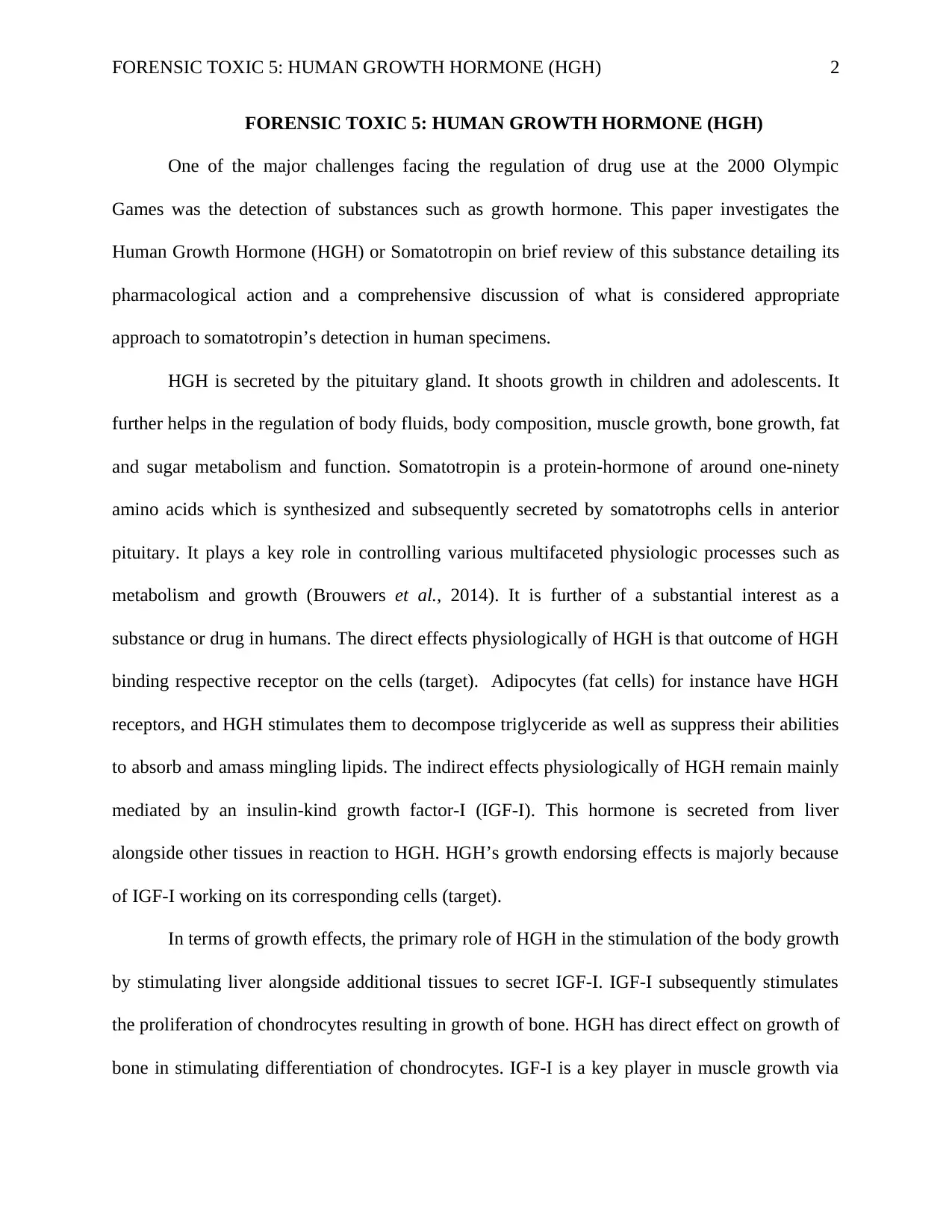
FORENSIC TOXIC 5: HUMAN GROWTH HORMONE (HGH) 2
FORENSIC TOXIC 5: HUMAN GROWTH HORMONE (HGH)
One of the major challenges facing the regulation of drug use at the 2000 Olympic
Games was the detection of substances such as growth hormone. This paper investigates the
Human Growth Hormone (HGH) or Somatotropin on brief review of this substance detailing its
pharmacological action and a comprehensive discussion of what is considered appropriate
approach to somatotropin’s detection in human specimens.
HGH is secreted by the pituitary gland. It shoots growth in children and adolescents. It
further helps in the regulation of body fluids, body composition, muscle growth, bone growth, fat
and sugar metabolism and function. Somatotropin is a protein-hormone of around one-ninety
amino acids which is synthesized and subsequently secreted by somatotrophs cells in anterior
pituitary. It plays a key role in controlling various multifaceted physiologic processes such as
metabolism and growth (Brouwers et al., 2014). It is further of a substantial interest as a
substance or drug in humans. The direct effects physiologically of HGH is that outcome of HGH
binding respective receptor on the cells (target). Adipocytes (fat cells) for instance have HGH
receptors, and HGH stimulates them to decompose triglyceride as well as suppress their abilities
to absorb and amass mingling lipids. The indirect effects physiologically of HGH remain mainly
mediated by an insulin-kind growth factor-I (IGF-I). This hormone is secreted from liver
alongside other tissues in reaction to HGH. HGH’s growth endorsing effects is majorly because
of IGF-I working on its corresponding cells (target).
In terms of growth effects, the primary role of HGH in the stimulation of the body growth
by stimulating liver alongside additional tissues to secret IGF-I. IGF-I subsequently stimulates
the proliferation of chondrocytes resulting in growth of bone. HGH has direct effect on growth of
bone in stimulating differentiation of chondrocytes. IGF-I is a key player in muscle growth via
FORENSIC TOXIC 5: HUMAN GROWTH HORMONE (HGH)
One of the major challenges facing the regulation of drug use at the 2000 Olympic
Games was the detection of substances such as growth hormone. This paper investigates the
Human Growth Hormone (HGH) or Somatotropin on brief review of this substance detailing its
pharmacological action and a comprehensive discussion of what is considered appropriate
approach to somatotropin’s detection in human specimens.
HGH is secreted by the pituitary gland. It shoots growth in children and adolescents. It
further helps in the regulation of body fluids, body composition, muscle growth, bone growth, fat
and sugar metabolism and function. Somatotropin is a protein-hormone of around one-ninety
amino acids which is synthesized and subsequently secreted by somatotrophs cells in anterior
pituitary. It plays a key role in controlling various multifaceted physiologic processes such as
metabolism and growth (Brouwers et al., 2014). It is further of a substantial interest as a
substance or drug in humans. The direct effects physiologically of HGH is that outcome of HGH
binding respective receptor on the cells (target). Adipocytes (fat cells) for instance have HGH
receptors, and HGH stimulates them to decompose triglyceride as well as suppress their abilities
to absorb and amass mingling lipids. The indirect effects physiologically of HGH remain mainly
mediated by an insulin-kind growth factor-I (IGF-I). This hormone is secreted from liver
alongside other tissues in reaction to HGH. HGH’s growth endorsing effects is majorly because
of IGF-I working on its corresponding cells (target).
In terms of growth effects, the primary role of HGH in the stimulation of the body growth
by stimulating liver alongside additional tissues to secret IGF-I. IGF-I subsequently stimulates
the proliferation of chondrocytes resulting in growth of bone. HGH has direct effect on growth of
bone in stimulating differentiation of chondrocytes. IGF-I is a key player in muscle growth via
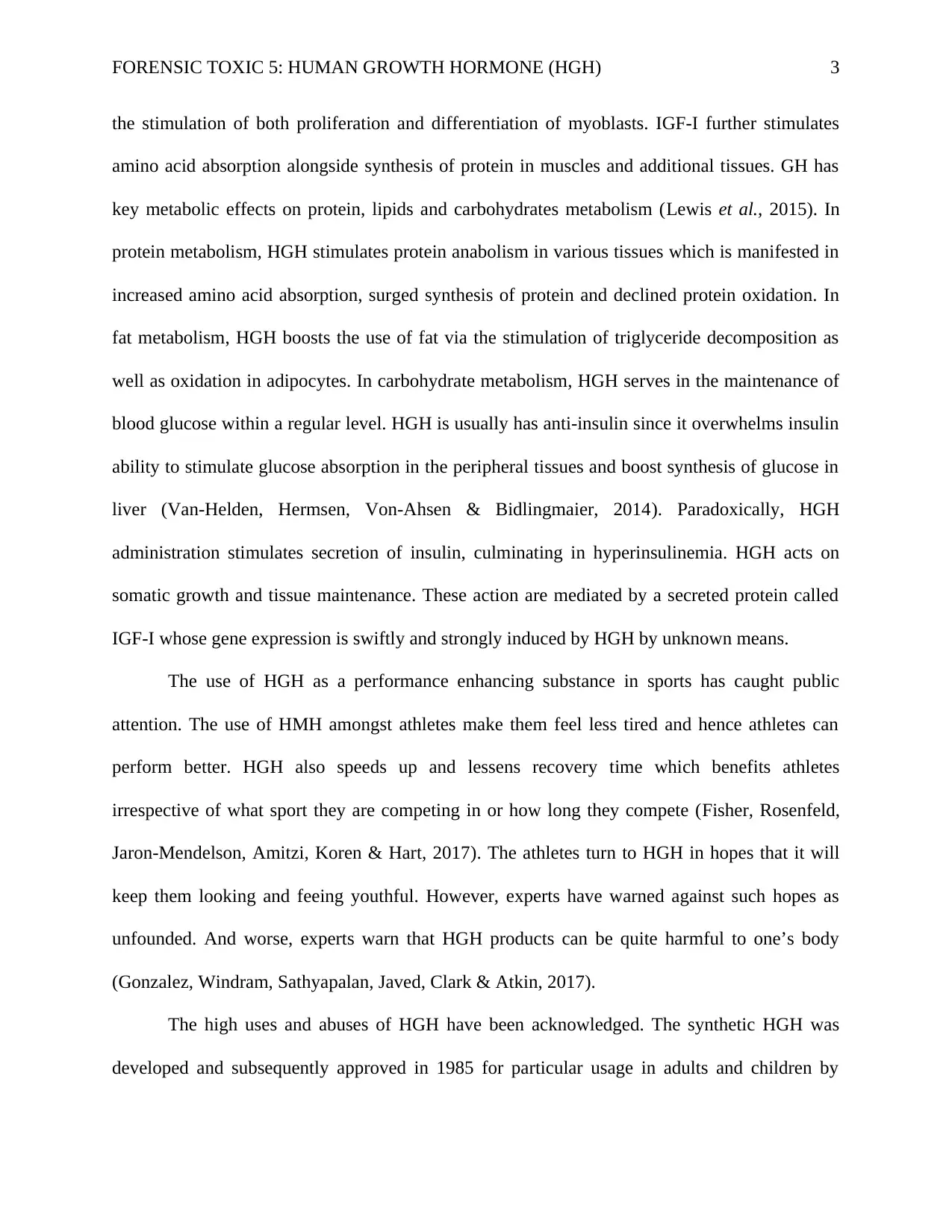
FORENSIC TOXIC 5: HUMAN GROWTH HORMONE (HGH) 3
the stimulation of both proliferation and differentiation of myoblasts. IGF-I further stimulates
amino acid absorption alongside synthesis of protein in muscles and additional tissues. GH has
key metabolic effects on protein, lipids and carbohydrates metabolism (Lewis et al., 2015). In
protein metabolism, HGH stimulates protein anabolism in various tissues which is manifested in
increased amino acid absorption, surged synthesis of protein and declined protein oxidation. In
fat metabolism, HGH boosts the use of fat via the stimulation of triglyceride decomposition as
well as oxidation in adipocytes. In carbohydrate metabolism, HGH serves in the maintenance of
blood glucose within a regular level. HGH is usually has anti-insulin since it overwhelms insulin
ability to stimulate glucose absorption in the peripheral tissues and boost synthesis of glucose in
liver (Van-Helden, Hermsen, Von-Ahsen & Bidlingmaier, 2014). Paradoxically, HGH
administration stimulates secretion of insulin, culminating in hyperinsulinemia. HGH acts on
somatic growth and tissue maintenance. These action are mediated by a secreted protein called
IGF-I whose gene expression is swiftly and strongly induced by HGH by unknown means.
The use of HGH as a performance enhancing substance in sports has caught public
attention. The use of HMH amongst athletes make them feel less tired and hence athletes can
perform better. HGH also speeds up and lessens recovery time which benefits athletes
irrespective of what sport they are competing in or how long they compete (Fisher, Rosenfeld,
Jaron-Mendelson, Amitzi, Koren & Hart, 2017). The athletes turn to HGH in hopes that it will
keep them looking and feeing youthful. However, experts have warned against such hopes as
unfounded. And worse, experts warn that HGH products can be quite harmful to one’s body
(Gonzalez, Windram, Sathyapalan, Javed, Clark & Atkin, 2017).
The high uses and abuses of HGH have been acknowledged. The synthetic HGH was
developed and subsequently approved in 1985 for particular usage in adults and children by
the stimulation of both proliferation and differentiation of myoblasts. IGF-I further stimulates
amino acid absorption alongside synthesis of protein in muscles and additional tissues. GH has
key metabolic effects on protein, lipids and carbohydrates metabolism (Lewis et al., 2015). In
protein metabolism, HGH stimulates protein anabolism in various tissues which is manifested in
increased amino acid absorption, surged synthesis of protein and declined protein oxidation. In
fat metabolism, HGH boosts the use of fat via the stimulation of triglyceride decomposition as
well as oxidation in adipocytes. In carbohydrate metabolism, HGH serves in the maintenance of
blood glucose within a regular level. HGH is usually has anti-insulin since it overwhelms insulin
ability to stimulate glucose absorption in the peripheral tissues and boost synthesis of glucose in
liver (Van-Helden, Hermsen, Von-Ahsen & Bidlingmaier, 2014). Paradoxically, HGH
administration stimulates secretion of insulin, culminating in hyperinsulinemia. HGH acts on
somatic growth and tissue maintenance. These action are mediated by a secreted protein called
IGF-I whose gene expression is swiftly and strongly induced by HGH by unknown means.
The use of HGH as a performance enhancing substance in sports has caught public
attention. The use of HMH amongst athletes make them feel less tired and hence athletes can
perform better. HGH also speeds up and lessens recovery time which benefits athletes
irrespective of what sport they are competing in or how long they compete (Fisher, Rosenfeld,
Jaron-Mendelson, Amitzi, Koren & Hart, 2017). The athletes turn to HGH in hopes that it will
keep them looking and feeing youthful. However, experts have warned against such hopes as
unfounded. And worse, experts warn that HGH products can be quite harmful to one’s body
(Gonzalez, Windram, Sathyapalan, Javed, Clark & Atkin, 2017).
The high uses and abuses of HGH have been acknowledged. The synthetic HGH was
developed and subsequently approved in 1985 for particular usage in adults and children by
⊘ This is a preview!⊘
Do you want full access?
Subscribe today to unlock all pages.

Trusted by 1+ million students worldwide
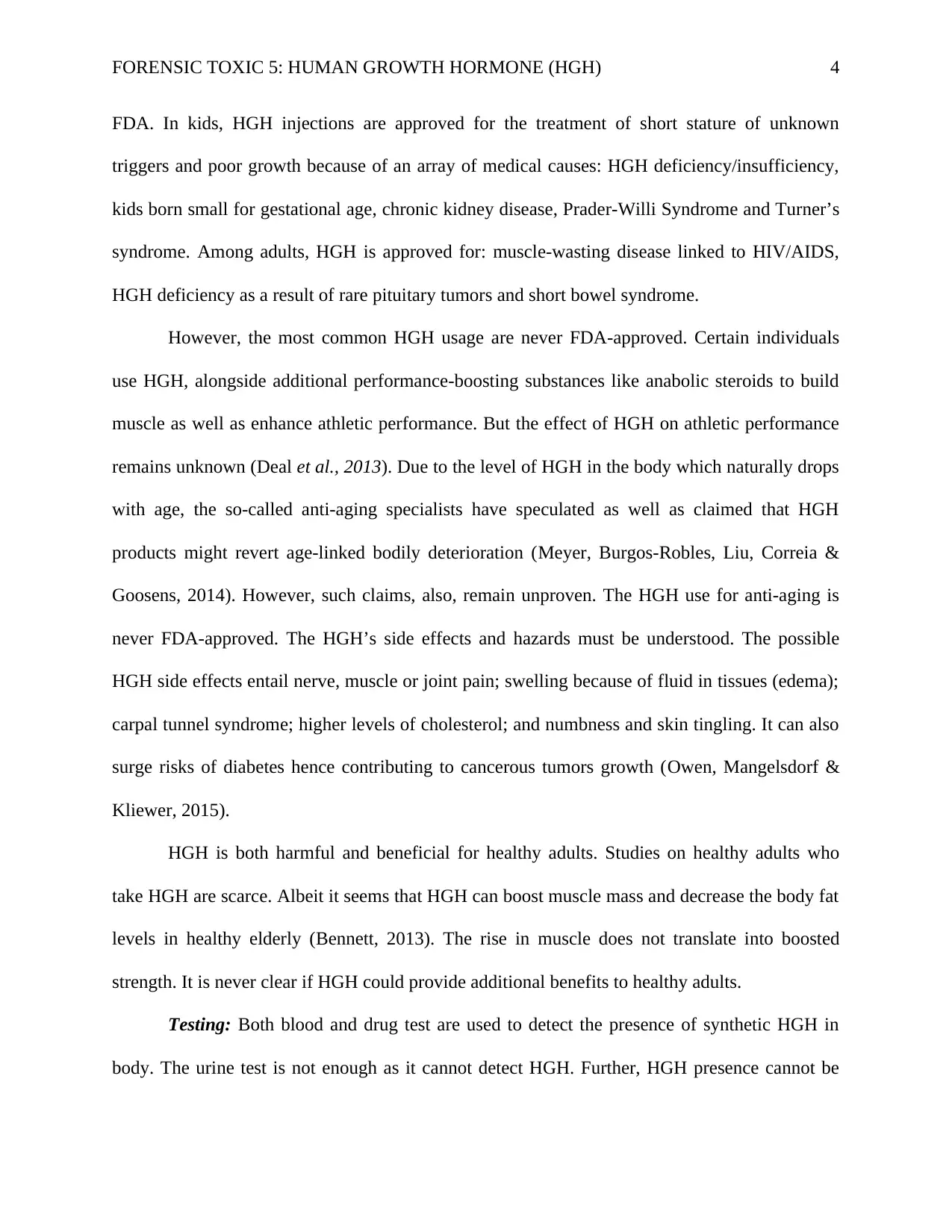
FORENSIC TOXIC 5: HUMAN GROWTH HORMONE (HGH) 4
FDA. In kids, HGH injections are approved for the treatment of short stature of unknown
triggers and poor growth because of an array of medical causes: HGH deficiency/insufficiency,
kids born small for gestational age, chronic kidney disease, Prader-Willi Syndrome and Turner’s
syndrome. Among adults, HGH is approved for: muscle-wasting disease linked to HIV/AIDS,
HGH deficiency as a result of rare pituitary tumors and short bowel syndrome.
However, the most common HGH usage are never FDA-approved. Certain individuals
use HGH, alongside additional performance-boosting substances like anabolic steroids to build
muscle as well as enhance athletic performance. But the effect of HGH on athletic performance
remains unknown (Deal et al., 2013). Due to the level of HGH in the body which naturally drops
with age, the so-called anti-aging specialists have speculated as well as claimed that HGH
products might revert age-linked bodily deterioration (Meyer, Burgos-Robles, Liu, Correia &
Goosens, 2014). However, such claims, also, remain unproven. The HGH use for anti-aging is
never FDA-approved. The HGH’s side effects and hazards must be understood. The possible
HGH side effects entail nerve, muscle or joint pain; swelling because of fluid in tissues (edema);
carpal tunnel syndrome; higher levels of cholesterol; and numbness and skin tingling. It can also
surge risks of diabetes hence contributing to cancerous tumors growth (Owen, Mangelsdorf &
Kliewer, 2015).
HGH is both harmful and beneficial for healthy adults. Studies on healthy adults who
take HGH are scarce. Albeit it seems that HGH can boost muscle mass and decrease the body fat
levels in healthy elderly (Bennett, 2013). The rise in muscle does not translate into boosted
strength. It is never clear if HGH could provide additional benefits to healthy adults.
Testing: Both blood and drug test are used to detect the presence of synthetic HGH in
body. The urine test is not enough as it cannot detect HGH. Further, HGH presence cannot be
FDA. In kids, HGH injections are approved for the treatment of short stature of unknown
triggers and poor growth because of an array of medical causes: HGH deficiency/insufficiency,
kids born small for gestational age, chronic kidney disease, Prader-Willi Syndrome and Turner’s
syndrome. Among adults, HGH is approved for: muscle-wasting disease linked to HIV/AIDS,
HGH deficiency as a result of rare pituitary tumors and short bowel syndrome.
However, the most common HGH usage are never FDA-approved. Certain individuals
use HGH, alongside additional performance-boosting substances like anabolic steroids to build
muscle as well as enhance athletic performance. But the effect of HGH on athletic performance
remains unknown (Deal et al., 2013). Due to the level of HGH in the body which naturally drops
with age, the so-called anti-aging specialists have speculated as well as claimed that HGH
products might revert age-linked bodily deterioration (Meyer, Burgos-Robles, Liu, Correia &
Goosens, 2014). However, such claims, also, remain unproven. The HGH use for anti-aging is
never FDA-approved. The HGH’s side effects and hazards must be understood. The possible
HGH side effects entail nerve, muscle or joint pain; swelling because of fluid in tissues (edema);
carpal tunnel syndrome; higher levels of cholesterol; and numbness and skin tingling. It can also
surge risks of diabetes hence contributing to cancerous tumors growth (Owen, Mangelsdorf &
Kliewer, 2015).
HGH is both harmful and beneficial for healthy adults. Studies on healthy adults who
take HGH are scarce. Albeit it seems that HGH can boost muscle mass and decrease the body fat
levels in healthy elderly (Bennett, 2013). The rise in muscle does not translate into boosted
strength. It is never clear if HGH could provide additional benefits to healthy adults.
Testing: Both blood and drug test are used to detect the presence of synthetic HGH in
body. The urine test is not enough as it cannot detect HGH. Further, HGH presence cannot be
Paraphrase This Document
Need a fresh take? Get an instant paraphrase of this document with our AI Paraphraser
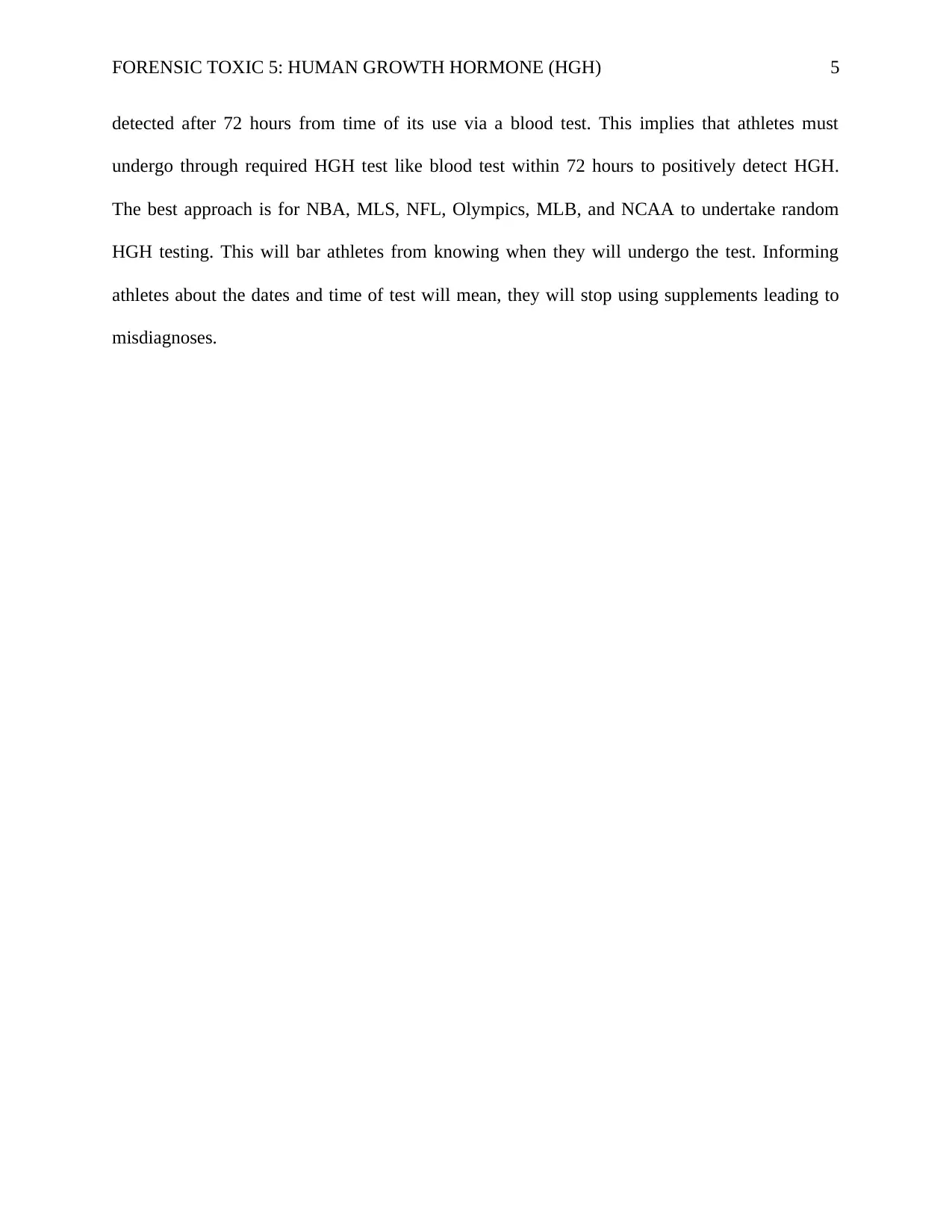
FORENSIC TOXIC 5: HUMAN GROWTH HORMONE (HGH) 5
detected after 72 hours from time of its use via a blood test. This implies that athletes must
undergo through required HGH test like blood test within 72 hours to positively detect HGH.
The best approach is for NBA, MLS, NFL, Olympics, MLB, and NCAA to undertake random
HGH testing. This will bar athletes from knowing when they will undergo the test. Informing
athletes about the dates and time of test will mean, they will stop using supplements leading to
misdiagnoses.
detected after 72 hours from time of its use via a blood test. This implies that athletes must
undergo through required HGH test like blood test within 72 hours to positively detect HGH.
The best approach is for NBA, MLS, NFL, Olympics, MLB, and NCAA to undertake random
HGH testing. This will bar athletes from knowing when they will undergo the test. Informing
athletes about the dates and time of test will mean, they will stop using supplements leading to
misdiagnoses.
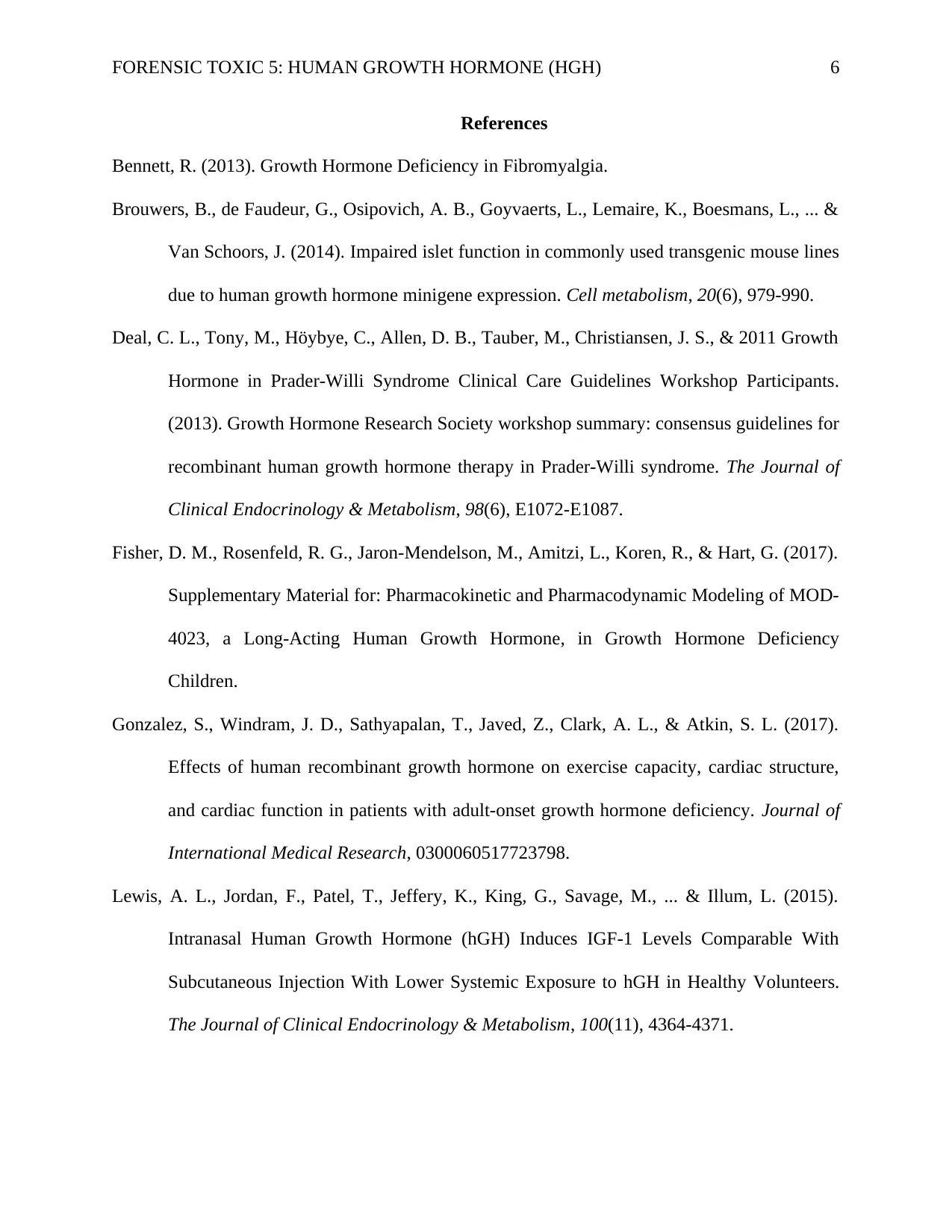
FORENSIC TOXIC 5: HUMAN GROWTH HORMONE (HGH) 6
References
Bennett, R. (2013). Growth Hormone Deficiency in Fibromyalgia.
Brouwers, B., de Faudeur, G., Osipovich, A. B., Goyvaerts, L., Lemaire, K., Boesmans, L., ... &
Van Schoors, J. (2014). Impaired islet function in commonly used transgenic mouse lines
due to human growth hormone minigene expression. Cell metabolism, 20(6), 979-990.
Deal, C. L., Tony, M., Höybye, C., Allen, D. B., Tauber, M., Christiansen, J. S., & 2011 Growth
Hormone in Prader-Willi Syndrome Clinical Care Guidelines Workshop Participants.
(2013). Growth Hormone Research Society workshop summary: consensus guidelines for
recombinant human growth hormone therapy in Prader-Willi syndrome. The Journal of
Clinical Endocrinology & Metabolism, 98(6), E1072-E1087.
Fisher, D. M., Rosenfeld, R. G., Jaron-Mendelson, M., Amitzi, L., Koren, R., & Hart, G. (2017).
Supplementary Material for: Pharmacokinetic and Pharmacodynamic Modeling of MOD-
4023, a Long-Acting Human Growth Hormone, in Growth Hormone Deficiency
Children.
Gonzalez, S., Windram, J. D., Sathyapalan, T., Javed, Z., Clark, A. L., & Atkin, S. L. (2017).
Effects of human recombinant growth hormone on exercise capacity, cardiac structure,
and cardiac function in patients with adult-onset growth hormone deficiency. Journal of
International Medical Research, 0300060517723798.
Lewis, A. L., Jordan, F., Patel, T., Jeffery, K., King, G., Savage, M., ... & Illum, L. (2015).
Intranasal Human Growth Hormone (hGH) Induces IGF-1 Levels Comparable With
Subcutaneous Injection With Lower Systemic Exposure to hGH in Healthy Volunteers.
The Journal of Clinical Endocrinology & Metabolism, 100(11), 4364-4371.
References
Bennett, R. (2013). Growth Hormone Deficiency in Fibromyalgia.
Brouwers, B., de Faudeur, G., Osipovich, A. B., Goyvaerts, L., Lemaire, K., Boesmans, L., ... &
Van Schoors, J. (2014). Impaired islet function in commonly used transgenic mouse lines
due to human growth hormone minigene expression. Cell metabolism, 20(6), 979-990.
Deal, C. L., Tony, M., Höybye, C., Allen, D. B., Tauber, M., Christiansen, J. S., & 2011 Growth
Hormone in Prader-Willi Syndrome Clinical Care Guidelines Workshop Participants.
(2013). Growth Hormone Research Society workshop summary: consensus guidelines for
recombinant human growth hormone therapy in Prader-Willi syndrome. The Journal of
Clinical Endocrinology & Metabolism, 98(6), E1072-E1087.
Fisher, D. M., Rosenfeld, R. G., Jaron-Mendelson, M., Amitzi, L., Koren, R., & Hart, G. (2017).
Supplementary Material for: Pharmacokinetic and Pharmacodynamic Modeling of MOD-
4023, a Long-Acting Human Growth Hormone, in Growth Hormone Deficiency
Children.
Gonzalez, S., Windram, J. D., Sathyapalan, T., Javed, Z., Clark, A. L., & Atkin, S. L. (2017).
Effects of human recombinant growth hormone on exercise capacity, cardiac structure,
and cardiac function in patients with adult-onset growth hormone deficiency. Journal of
International Medical Research, 0300060517723798.
Lewis, A. L., Jordan, F., Patel, T., Jeffery, K., King, G., Savage, M., ... & Illum, L. (2015).
Intranasal Human Growth Hormone (hGH) Induces IGF-1 Levels Comparable With
Subcutaneous Injection With Lower Systemic Exposure to hGH in Healthy Volunteers.
The Journal of Clinical Endocrinology & Metabolism, 100(11), 4364-4371.
⊘ This is a preview!⊘
Do you want full access?
Subscribe today to unlock all pages.

Trusted by 1+ million students worldwide
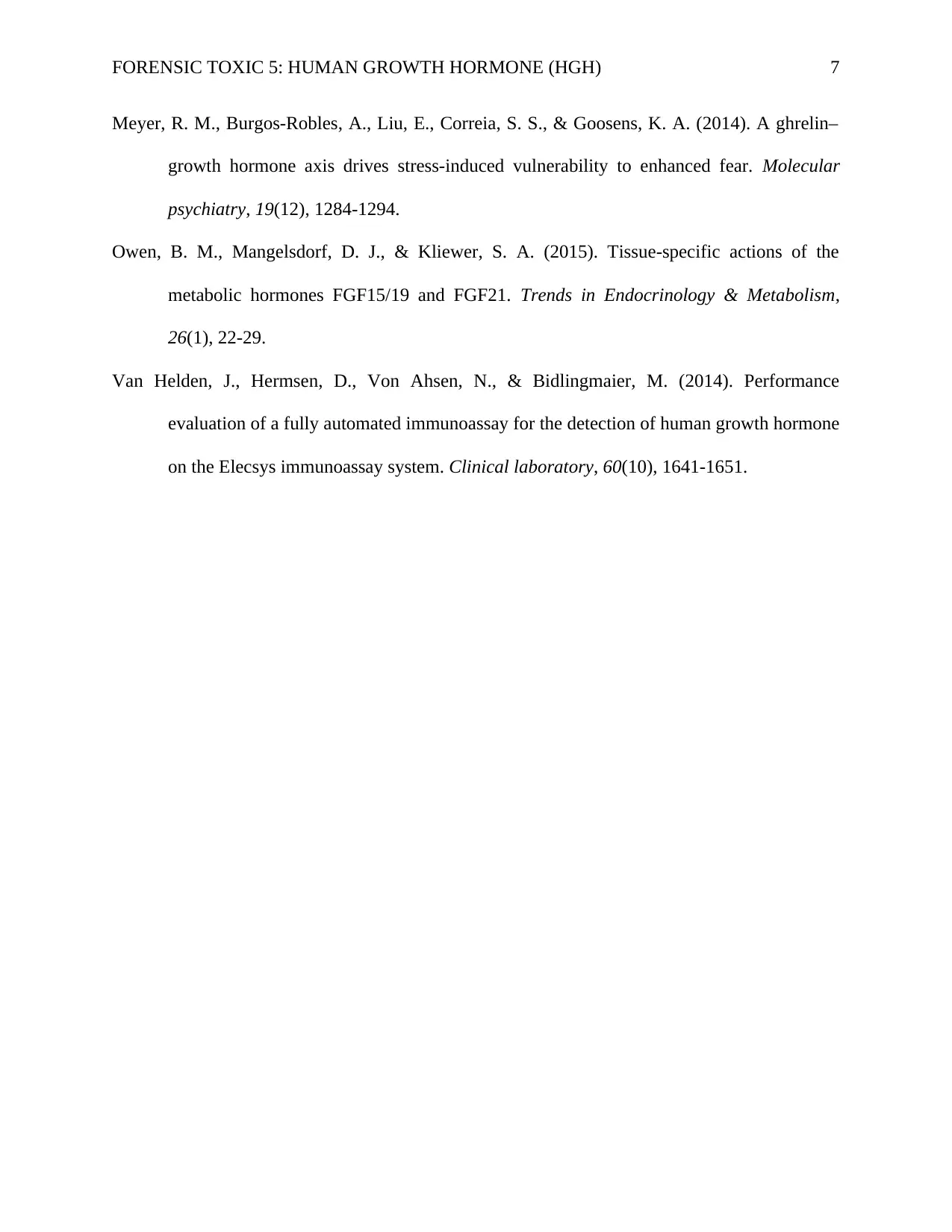
FORENSIC TOXIC 5: HUMAN GROWTH HORMONE (HGH) 7
Meyer, R. M., Burgos-Robles, A., Liu, E., Correia, S. S., & Goosens, K. A. (2014). A ghrelin–
growth hormone axis drives stress-induced vulnerability to enhanced fear. Molecular
psychiatry, 19(12), 1284-1294.
Owen, B. M., Mangelsdorf, D. J., & Kliewer, S. A. (2015). Tissue-specific actions of the
metabolic hormones FGF15/19 and FGF21. Trends in Endocrinology & Metabolism,
26(1), 22-29.
Van Helden, J., Hermsen, D., Von Ahsen, N., & Bidlingmaier, M. (2014). Performance
evaluation of a fully automated immunoassay for the detection of human growth hormone
on the Elecsys immunoassay system. Clinical laboratory, 60(10), 1641-1651.
Meyer, R. M., Burgos-Robles, A., Liu, E., Correia, S. S., & Goosens, K. A. (2014). A ghrelin–
growth hormone axis drives stress-induced vulnerability to enhanced fear. Molecular
psychiatry, 19(12), 1284-1294.
Owen, B. M., Mangelsdorf, D. J., & Kliewer, S. A. (2015). Tissue-specific actions of the
metabolic hormones FGF15/19 and FGF21. Trends in Endocrinology & Metabolism,
26(1), 22-29.
Van Helden, J., Hermsen, D., Von Ahsen, N., & Bidlingmaier, M. (2014). Performance
evaluation of a fully automated immunoassay for the detection of human growth hormone
on the Elecsys immunoassay system. Clinical laboratory, 60(10), 1641-1651.
1 out of 7
Related Documents
Your All-in-One AI-Powered Toolkit for Academic Success.
+13062052269
info@desklib.com
Available 24*7 on WhatsApp / Email
![[object Object]](/_next/static/media/star-bottom.7253800d.svg)
Unlock your academic potential
Copyright © 2020–2025 A2Z Services. All Rights Reserved. Developed and managed by ZUCOL.




